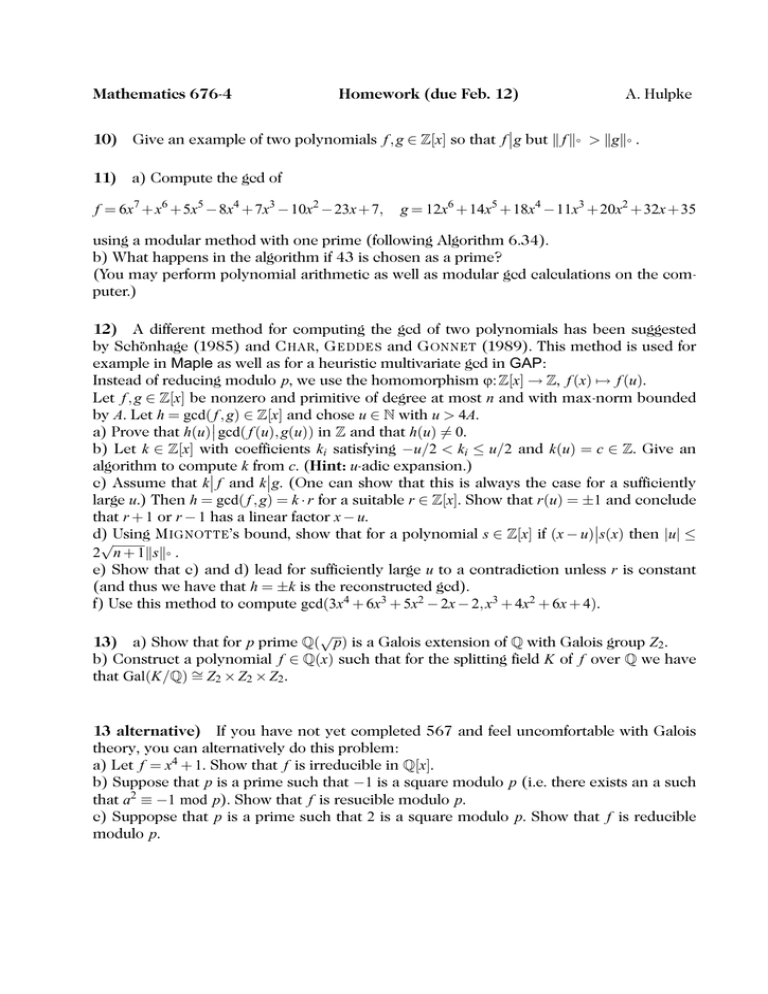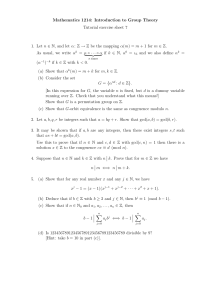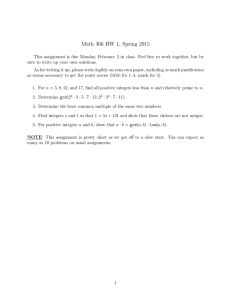Mathematics 676-4 Homework (due Feb. 12) 10) 11)
advertisement

Mathematics 676-4 Homework (due Feb. 12) A. Hulpke 10) Give an example of two polynomials f , g ∈ Z[x] so that f g but k f k∞ > kgk∞ . 11) a) Compute the gcd of f = 6x7 +x6 +5x5 −8x4 +7x3 −10x2 −23x+7, g = 12x6 +14x5 +18x4 −11x3 +20x2 +32x+35 using a modular method with one prime (following Algorithm 6.34). b) What happens in the algorithm if 43 is chosen as a prime? (You may perform polynomial arithmetic as well as modular gcd calculations on the computer.) 12) A different method for computing the gcd of two polynomials has been suggested by Schönhage (1985) and C HAR, G E DDE S and G ON N ET (1989). This method is used for example in Maple as well as for a heuristic multivariate gcd in GAP: Instead of reducing modulo p, we use the homomorphism ϕ: Z[x] → Z, f (x) 7→ f (u). Let f , g ∈ Z[x] be nonzero and primitive of degree at most n and with max-norm bounded by A. Let h = gcd(f , g) ∈ Z[x] and chose u ∈ N with u > 4A. a) Prove that h(u) gcd( f (u), g(u)) in Z and that h(u) 6= 0. b) Let k ∈ Z[x] with coefficients ki satisfying −u/2 < ki ≤ u/2 and k(u) = c ∈ Z. Give an algorithm to compute k from c. (Hint: u-adic expansion.) c) Assume that k f and kg. (One can show that this is always the case for a sufficiently large u.) Then h = gcd( f , g) = k · r for a suitable r ∈ Z[x]. Show that r(u) = ±1 and conclude that r + 1 or r − 1 has a linear factor x − u. d) Using M IG NOTTE’s bound, show that for a polynomial s ∈ Z[x] if (x − u)s(x) then |u| ≤ √ 2 n + 1ksk∞ . e) Show that c) and d) lead for sufficiently large u to a contradiction unless r is constant (and thus we have that h = ±k is the reconstructed gcd). f) Use this method to compute gcd(3x4 + 6x3 + 5x2 − 2x − 2, x3 + 4x2 + 6x + 4). √ 13) a) Show that for p prime Q( p) is a Galois extension of Q with Galois group Z2 . b) Construct a polynomial f ∈ Q(x) such that for the splitting field K of f over Q we have that Gal(K/Q) ∼ = Z2 × Z2 × Z2 . 13 alternative) If you have not yet completed 567 and feel uncomfortable with Galois theory, you can alternatively do this problem: a) Let f = x4 + 1. Show that f is irreducible in Q[x]. b) Suppose that p is a prime such that −1 is a square modulo p (i.e. there exists an a such that a2 ≡ −1 mod p). Show that f is resucible modulo p. c) Suppopse that p is a prime such that 2 is a square modulo p. Show that f is reducible modulo p. d) Suppopse that p is a prime such that −2 is a square modulo p. Show that f is reducible modulo p. e) Show that for a prime p if neither −1, nor 2 are a square modulo p, then −2 must be a square modulo p. Conclude that f is reducible modulo every prime. Polynomials of various characteristic in GAP Polynomials in GAP are defined in a particular characteristic (given for example by the field over which the indeterminate X was created). Using the functions CoefficientsOfUnivariatePolynomial and UnivariatePolynomial (careful: UnivariatePolynomialByCoefficients has different syntax!) it is possible to create new polynomials in different characteristic: gap> f:=3*xˆ4+6*xˆ3+5*xˆ2-2*x-2; 3*xˆ4+6*xˆ3+5*xˆ2-2*x-2 gap> fmod:=UnivariatePolynomial(GF(5), > CoefficientsOfUnivariatePolynomial(f)*One(GF(5)), > 1); Z(5)ˆ3*x_1ˆ4+x_1ˆ3+Z(5)ˆ3*x_1+Z(5)ˆ3 gap> UnivariatePolynomial(Rationals, > List(CoefficientsOfUnivariatePolynomial(fmod),Int), > 1); 3*xˆ4+xˆ3+3*x+3 (The last parameter (1) gives the indeterminate number. As long as we work with univariate polynomials it will typically be always the same, say 1).






